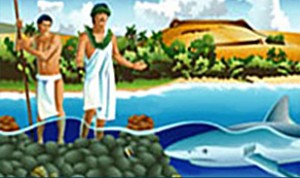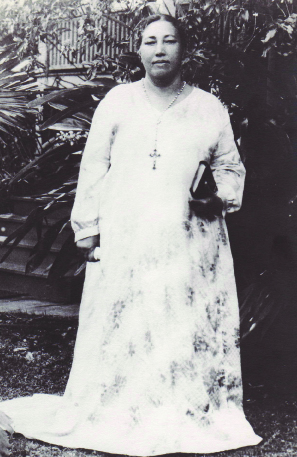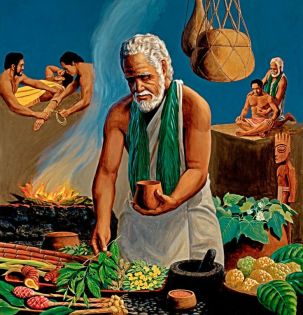Over the past couple of years, I have written down some of my memories of growing up and listening to the words of my kūpuna. Seventy years ago it was clearly the responsibility of children to be SEEN and not HEARD in gatherings. In the presence of adults we were to keep quiet while they shared thoughts or go and fetch something they had left outside or in the other room. This gave us a lot of time to listen as they shared stories, insights, frustrations and aloha with each other. All these times, woven together with impromptu songs and spontaneous hula, usually ended with Uncle Larry Holt’s tremendous basso voice combined with Aunty Emma’s lyric soprano in the Hawaiian wedding song! Heady stuff for a five or six year old and things cherished still in my old age!

Lots of history, family lore, strident opinions, and gossip swirled around during those ‘ohana nights at our house. All of the latest tales in the relatively small Hawaiian professional community were shared and amplified with heads shaking and phrases like, “Can you believe….?” as they were exchanged across the room. The spicier bits of gossip were whispered out of the hearing of our young ears and usually accompanied with significant eye movements. The stories that were shared in the presence of the kids are the ones that have remained vivid memories throughout my life. A couple of them I’d like to share with you in this posting.
I got to know my mother’s cousin, Joseph Hinau, after college. Uncle Joe was the elder Hawaiian member of our Hawaiian extended family, a bachelor, and a gifted story teller and prankster. Uncle Joe and I hit it off and I was always eager to go get him and bring him to the ‘ohana gatherings. During one of our hours in the car, Uncle Joe shared with me the story of our ‘aumākua (family protector), Manō, the shark. Uncle Joe had been given to his Tūtū when he was an infant and was raised under the guidance of his grandfather. It was through this relationship and the tutoring of his grandfather, that he learned of our family’s connection to the shark and the importance of this animal in our family’s history. Uncle Joe said that as he was growing up, each week his Tūtū would get up early in the morning, dress in a red malo, and fill a large ‘umeke (calabash) with food. Uncle Joe would accompany his grandfather to the beach outside Lāhainā and watch as Tūtū would slap the water, wait until a huge shark swam up to him, and then feed the shark from the ‘umeke! Uncle Joe said that the shark was a part of the ‘ohana and a protector of the family. He said it was huge, but fed peacefully from his grandfather’s hand.
It took me a few weeks to digest the story, but Uncle Joe insisted it was a real part of the family’s legacy. As I thought about the relationship Hawaiians have to their guardian entities, I was reminded that my uncles often spoke of Tūtū wahine’s adventures at the beach picking seaweed and shellfish and how time and time again sharks would appear to hover around her and to steer her away from danger. It was part of our family’s connection to the world and to all the life that surrounded them. I was told that when a family member died, their remains were taken to caves and when all that was left were bones, they were gathered and carried out and committed to the ocean. The assumption was that they became the guardian Manō to protect their relatives. All of this still rolls around in my head from time to time, but it is a comfort when I’m alone swimming in the deep! Just last year my son and my grandson were part of an ‘ohana visit to the graves of our kūpuna in Kalaupapa, the former leper community on Moloka‘i. Both of my boys were swimming off the pier for a few minutes and then climbed back on the pier. When they sat down, they saw that a large shark had been their companion in the ocean! Coincidence? Perhaps.

In traditional Hawaiian culture, ‘aumākua are ancestral spirits that may take possession of a living creature or have a resting place on a certain inanimate object (e.g., the stern of a family member’s canoe may be regarded as their ‘aumākua’s “seat”). ‘Aumākua often appear as a particular animal for a particular purpose, such as to offer protection for the living, warn of impending danger, provide comfort in times of stress or sorrow, or to be helpful in other ways. In return, their living descendants show their respect and appreciation by feeding and caring for their ‘aumākua and through the manner in which they live. (For more about sharks as ‘aumākua, see the following articles from the perspectives of Kahu Charles Kauluwehi Maxwell, Sr. and Herb Kawainui Kāne).
The other family curiosity concerns my younger uncle, Alfred K. Chock, the baby of my mother’s siblings. He and my Tūtū wahine were very close and she, a kahuna lā‘au lapa‘au, had an amazing set of gifts for healing and speaking the future. People would come from all over Kohala and the islands in general to get her advice and ask for her healing. Not once would she take money claiming anything she did was thanks to Ke Akua, not her skills. A great attitude for all of us to embrace.

My uncle came from Hawi on Hawai‘i Island to study at McKinley High School and subsequently to take a job at the U.S. Postal Service. The family story goes that Uncle Alfred’s roommate came down with an illness no one could cure. Suddenly, grandmother writes Uncle Al to ask if anyone had been using his clothes. When he replied that his roommate had used his shirt, she immediately told him to remember that she had warned him not to allow others outside the family to use his clothes because of the curse he was carrying due to her work of healing. She told him what to do and his friend was healed, but the “curse” was never fully explained and remains a family mystery.

For over a thousand years kahuna lā‘au lapa‘au (healers/medical practitioners) were called upon to heal and protect Hawaiians, including chiefs, often battling a spiritual conflict or evil that resulted in illness. With the arrival of English missionaries (and medicine that could cure the Western diseases that ravaged the Hawaiian community), Westerners often confused kahuna lā‘au lapa‘au with kahuna ‘anā ‘anā (a “black magic sorcerer” who prayed death upon another). Kahuna lā‘au lapa‘au were ridiculed and considered heathens, and an eventual ban forced them to practice underground until the Hawaiian revitalization movement in the late 1960s and early 1970s. But by then, many healers were well into their seventies and eighties and their practices were in danger of being forever lost.
All of the above is a small part of the stories shared in the numerous “talk story” sessions we listened to as children and young adults. Some of it is perplexing, but all of it builds the history and “culture” of one’s family and through that, our own personal character and understanding of our responsibilities to each other and to the larger community. We are all part of a complex fabric of relationships and traditions and we all should actively and intentionally seek to understand our connection. We will grow stronger and our family will be blessed. Reflect on who you are and what you have received from those going before you. Blessings this Easter season.
